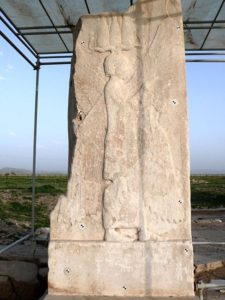The Story: 539 BCE-632 CE, MyJewishLearning.com.
Jerusalem under Persian, Greek, Roman, and Muslim Rule
 539 BCE witnessed the arrival of Cyrus, the Persian emperor, in Babylon (southern Iraq), effectively inheriting the vast Babylonian empire including Palestine. Rather than employing the policies of conquest and exile like their Babylonian and Assyrian predecessors, the Persian emperors viewed themselves as liberators and restorers. Cyrus and his successors encouraged exiled peoples to return to their native lands and rebuild their religious and cultural institutions there.
539 BCE witnessed the arrival of Cyrus, the Persian emperor, in Babylon (southern Iraq), effectively inheriting the vast Babylonian empire including Palestine. Rather than employing the policies of conquest and exile like their Babylonian and Assyrian predecessors, the Persian emperors viewed themselves as liberators and restorers. Cyrus and his successors encouraged exiled peoples to return to their native lands and rebuild their religious and cultural institutions there.
Many members of the exiled Jewish community in Babylon took advantage of this new Persian policy. Under the leadership of the prophets Ezra and Nehemiah, several waves of Jews headed towards their ancestral homeland, in the former territory of the Kingdom of Judah. They gained autonomy and were eventually permitted to rebuild the Temple, the focal point of their religion.
The biblical books of Ezra and Nehemiah attest to conflicts with fellow Jews who had not been exiled, as well as with neighboring peoples, obstructing and delaying the rebuilding process. Moreover, Judah was a Persian province; the Jews had only achieved token autonomy. A longing for true independence figures prominently in the literature of the Second Temple period (539 BCE-70 CE).
Persian rule was nonetheless more amicable than that under the Greek and Roman empires that followed. In 332 BCE, Alexander the Great extended his empire into Judea (the Greek and Latin term for Judah). Within a decade, however, Alexander was dead, and his empire dissolved into competing factions.
For the Jews, this instability was especially traumatic, as their land served as a constant battleground between the rivaling Seleucids (in Syria) and Ptolemies (of Egypt). The Greeks caused additional tensions by interfering in religious matters, levying heavy taxes, and encouraging the Jews to adopt Greek culture. These factors, combined with Jewish infighting and the continued desire for autonomy, eventually led to the Maccabean revolt, an effort that achieved a brief period of independence in the middle of the second century BCE. The situation changed little with the arrival of the Romans in the first-century BCE.
The Roman emperors tended to rule from afar, appointing local leaders to handle day-to-day affairs. Perhaps the most famous of these leaders was Herod, known for his great building achievements, his efforts to appease both the Romans and Jews, his quest for stature, and his paranoia.
Like their Greek predecessors, the rulers of Judea during the Roman period extracted heavy taxes on Judea, and often offended Jewish monotheistic sensibilities. Tensions brewed and came to a head with a full-fledged revolt beginning in 66 CE. The Romans responded with a series of assaults culminating in the destruction of the Temple in 70 CE.
After the fall of the Temple, the war between the Romans and the Jews continued for three more years, until the defeat of the Jews with the fall of Masada in 73 CE. According to the first century historian Josephus, 960 men women and children committed suicide rather than surrender the desert fortress of Masada to the Romans.
In 115 CE revolt broke out again, this time Jews in the diaspora communities rose up against the Romans. (During the Hellenistic and Roman periods, Jews established communities in new regions, including Egypt, Asia Minor and the Roman Empire.) Again the Romans armies emerged victorious.
The last armed attempt to overthrow the Romans occurred between 132 and 135 CE. Deemed the Bar Kokhba Revolt, after the man who led the Jews, this action was an attempt to liberate the Jews from their Roman oppressors who had outlawed circumcision and replaced Jerusalem with a pagan city. The rebellion was crushed after three and a half years of battle during which hundred of thousands of Jews died, a reality that changed the ethnic make-up of the land. Although probably still a majority overall, Jews existed as a minority or not at all some regions.
Around the time of the Bar Kokhba rebellion (exact date unknown), the Roman Emperor Hadrian changed the name of the province from Judea to Palestina in an effort to mitigate the Jewish connection to the land.
The Roman Empire became Christian in 315 CE, placing Palestine under dual law- Roman and Christian. The legal and social status of the Jews was redefined; new laws regulated Jewish marriage, commerce, synagogue construction and Jewish-Christian social relations. For example, Jews were not permitted to own Christian slaves.
Roman/Byzantine rule of Palestine continued through the beginning of the seventh century, when the Persians, then the Arabs won the land. From 638, Jerusalem was under Muslim control. Muslim leaders recognized the Jews as monotheists, and this gave them a degree of protection during the early years of Islam.



